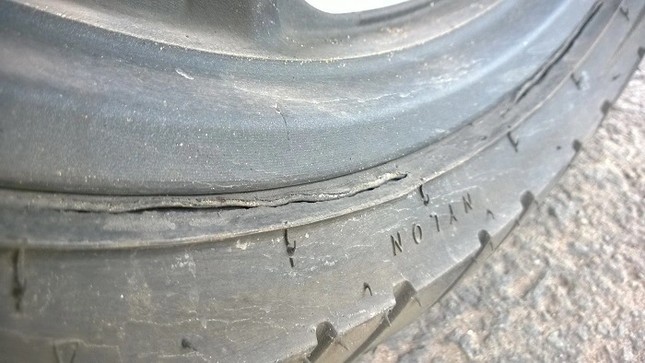Tire Puncture, Loss of Airtightness
If nails or small pieces of metal pierce the tire, it will not completely deflate, but instead experience slow air loss over a few days or possibly weekly. This is a common cause of slow tire deflation.
If small foreign objects tend to deeply penetrate the tire and are covered by the tire’s surface, it becomes difficult to visually detect them. To check, use soapy water to coat the tire’s surface evenly. At this point, air escaping from the locations with foreign objects will create bubbles, making it easier to mark and remove the objects.
Loss of airtightness in the tire is also a common cause of slow deflation, as drivers often try to save money by using tires longer than the manufacturer’s recommended lifespan.

Expired tires will develop cracks leading to slow deflation.
When tires are expired, tire tread blocks lose their elasticity and no longer interlock, creating small gaps commonly referred to as punctures. The tire edges also lose their ability to adhere to the surface of the wheel, resulting in a loss of airtightness.
This condition not only requires frequent tire inflation but can also lead to tire rupture and blowouts. This is particularly dangerous when driving at high speeds.
In addition to the tire condition, tire valves can also be a cause of slow deflation. Valves can be damaged by impacts or improper installation, as well as aging over time. In this case, the driver should check and replace the valve without needing to replace the entire tire.
Warped and Buckled Wheel Rims
The wheel rims can easily become warped or buckled due to external forces. In this case, the surface of the rims does not seal tightly with the tire bead, leading to slow tire deflation. To fix this issue, the driver should visit reputable repair facilities for alignment and restoration of wheel rims.

Unmatched surface between the wheel rim and tire bead leads to slow tire deflation.
Driving with deformed wheel rims not only causes damage to related systems such as the suspension system and steering system, as well as the tires, but also poses potential risks of accidents. Signs of warped and buckled rims can be identified by the naked eye or through indicators such as unusual noise at the wheel well when operating the vehicle, off-center steering, and dynamic imbalance.
To easily monitor and detect issues related to tire pressure, vehicle owners should equip their cars with a Tire Pressure Monitoring System (TPMS), which costs between 1-2 million VND depending on the type (built-in or external).
This device helps monitor tire pressure in real-time, providing accurate tire pressure and temperature readings at any given time. Vehicle owners can also purchase handheld electronic tire pressure gauges to proactively measure tire pressure daily.
Additionally, drivers should also equip themselves with handheld tire inflators that can be powered by a car charger with an integrated pressure gauge, making it easy to inflate tires in emergency situations.
Source: Bao giaothong


































